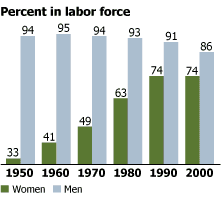
Gender Inequality at Work
The following excerpt is from the report Gender Inequality at Work, by David A. Cotter, Joan M. Hermsen, and Reeve Vanneman, and published by the Russell Sage Foundation and the Population Reference Bureau. This report is one of several in the new series, “The American People,” which sets the results of Census 2000 in context and collectively provides a portrait of the American people in a new century. Each report is written by an author or team of authors selected for their expertise with the data and their broad understanding of the implications of demographic trends.
(November 2004) Women’s increased participation in paid work is a central change in gender relations over the last 50 years. The question is no longer whether the average woman will work or not, but rather when during her life course she will work. Most women now work—women at all education levels, of each racial and ethnic group, and across successive family statuses.
Labor force participation is often seen as the prime indicator (and cause) of changes in women’s status. As far back as Friedrich Engels’ or Charlotte Perkins Gilman’s writings on the subject in the late 1800s, social scientists and other observers have identified employment outside the home as the starting point for understanding women’s position in society. Social theory often focuses on women’s employment because employment determines their access to resources and their ability to make independent decisions.
By the year 2000, only a small margin separated men’s and women’s presence in the labor force. Nearly 74 percent of women ages 25 to 54 were in the paid labor force, either looking for work or actually working at least part-time. Men’s rates were only slightly higher, at 86 percent. Gender difference was somewhat larger for full-time/year-round employment. In 1999, 46 percent of women and 68 percent of men ages 25 to 54 were employed full-time/year-round.
Figure
Labor Force Participation for U.S. Women and Men, 1950–2000

Note: Labor force participation calculated for men and women ages 25–54.
Source: Authors’ calculations using the Integrated Public Use Microdata Series (IPUMS), 2003.
These gender differences are small in historical perspective. Consistent with popular perception, women were much more likely to work outside the home by the end of the 20th century than at any time since 1950. As shown in the figure, women ages 25 to 54 have increased their labor force participation rate steadily, by between 8 percentage points and 14 percentage points for each decade from 1950 to 1990. In 1950, only 33 percent of women were in the paid labor force. By 1970, that figure had increased to 49 percent, and by 1990, to 74 percent. This upward trend has often been interpreted to signify women’s increasing equality with men. The growth in labor force participation is also cited as an underlying cause for other changes in gender relations such as marital power, fertility patterns, and political representation.
Census 2000 shows no similar increase in women’s labor force participation rate during the 1990s. The reported 2000 women’s labor force participation rate of 74 percent is not notably different from the 1990 rate. Some of the stagnation in the 1990s is exaggerated by a slight change in wording of the Census 2000 employment question that depressed reports of labor force participation. But stagnation during the 1990s was also seen in the annual CPS, where the question’s wording did not change. Like the census, the CPS recorded large increases in the past—from 48 percent in 1970 to 74 percent in 1990. The CPS rate in 2000 was 78 percent, slightly higher than the 1990 Census rate but still far below what would have been expected based on increases of previous decades.
The end of increasing labor force participation for women in the 1990s is surprising. It is too early to say if this lack of change is temporary; perhaps the strong 1990s’ economy allowed a reemergence of the single-paycheck family. To understand this finding, it is important to recognize how the patterns of women’s labor force participation, and particularly how the changes in the 1990s, have varied across groups of women.
David A. Cotter is an associate professor of sociology at Union College in Schenectady, New York. Joan M. Hermsen is an associate professor of sociology at the University of Missouri, Columbia. Reeve Vanneman is a professor of sociology at the University of Maryland, College Park.
